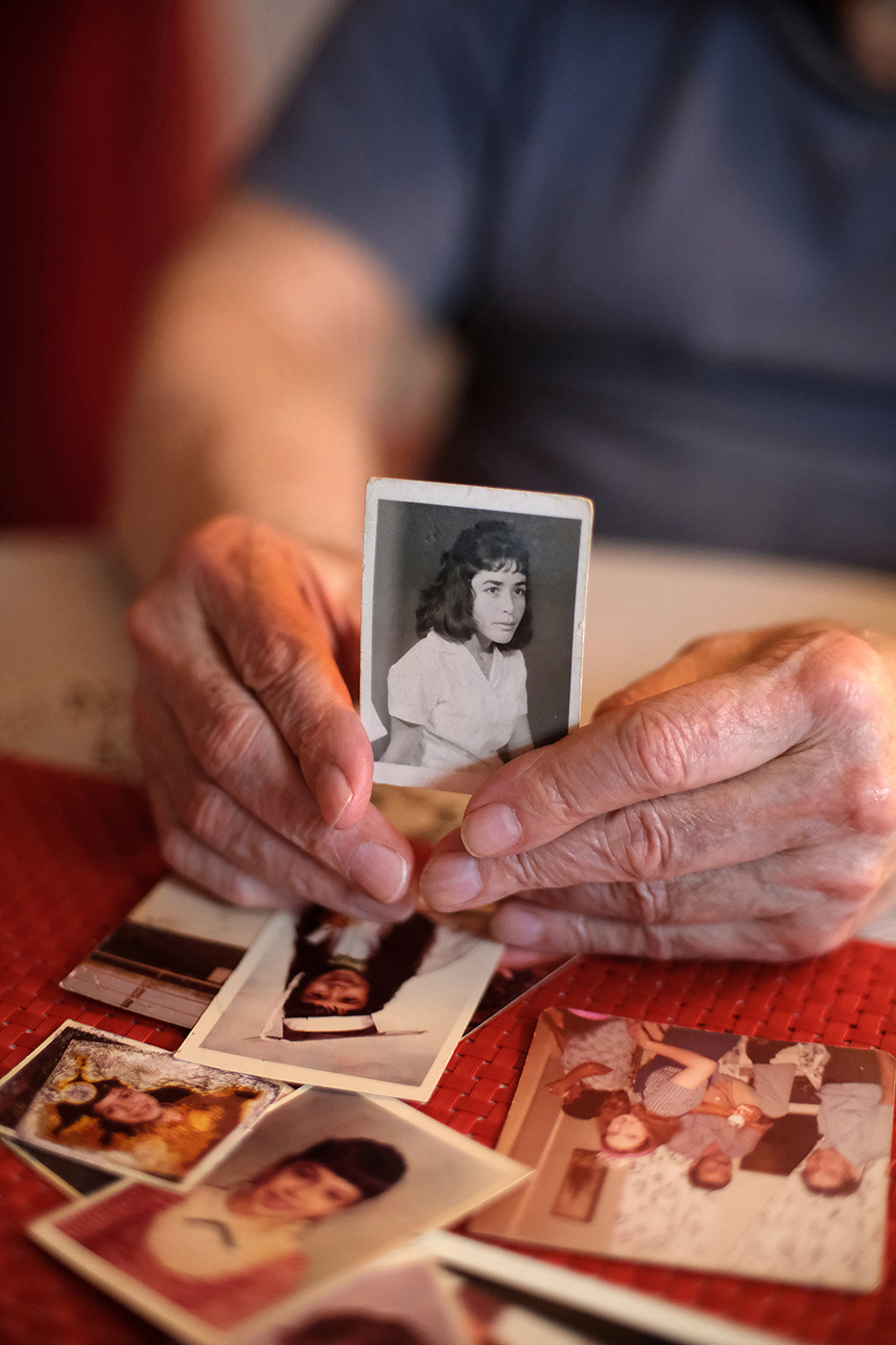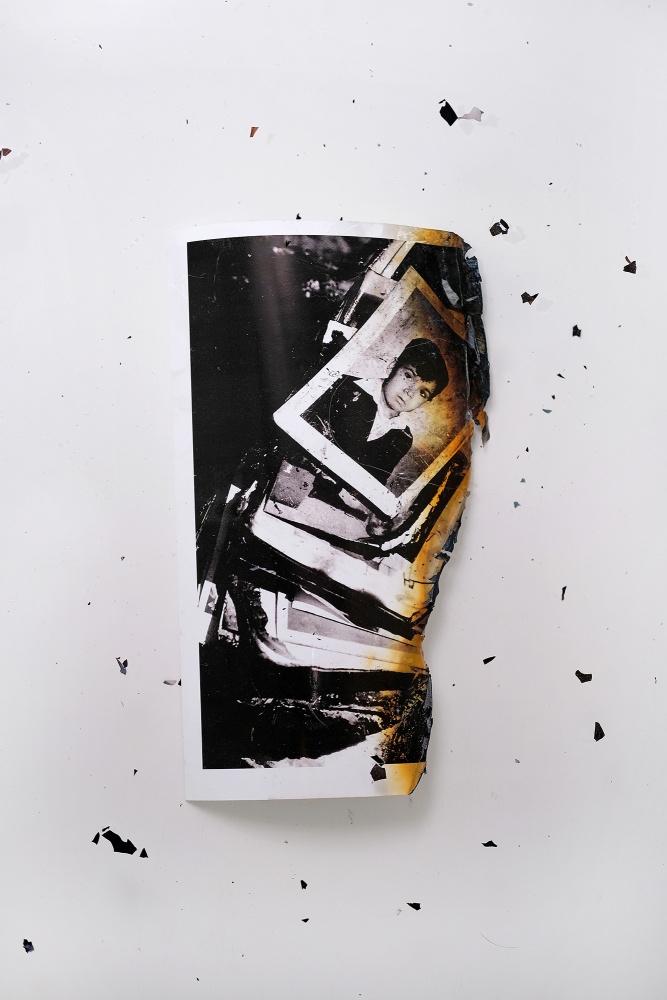
(Artwork © Christopher López; photograph provided by the artist)
The Fires: Hoboken’s History of Gentrification & Arson for Profit is a long-form historical project that began in January of 2021. Initially, my interest was to understand how cities come to be gentrified and so I began by looking at the areas around me that I knew were gentrified places. At the time, I was living in Newark, so I gravitated toward Hoboken as a place of interest because of its proximity to me. I knew, that like Williamsburg in Brooklyn, Hoboken, too, had at one time boasted a large Puerto Rican population. As a person of Puerto Rican descent, I took immediate interest in the subject of displacement of Puerto Rican communities as I have dedicated most of my art practice to creating narratives surrounding our diminished histories. Upon my initial search, I found only one piece of writing on the subject, an essay titled, “Hoboken Is Burning: Yuppies, Arson, and Displacement in the Postindustrial City,” by Dylan Gottlieb, a historian at Bentley University in Massachusetts.1 The history of violence detailed in those twenty-seven pages was hard to face, and even harder was that it was the only piece of critical writing of this history. I quickly became consumed by this seemingly unknown piece of Hoboken’s development and spent the better part of a year doing my own independent research utilizing whatever online resources I could find. I began by creating a timeline of the events to include all the major fires and people connected to them. After about six months of research, I was left with the daunting realization that what was missing from this history were the voices of those people themselves. I decided that the only way to truly understand the repercussions of gentrification was to hear from the people who had been affected by it. My observations revealed how gentrification operates coercively in its methods by employing violence. However, what I longed to know the most was how this loss—of someone’s home and family—was felt.
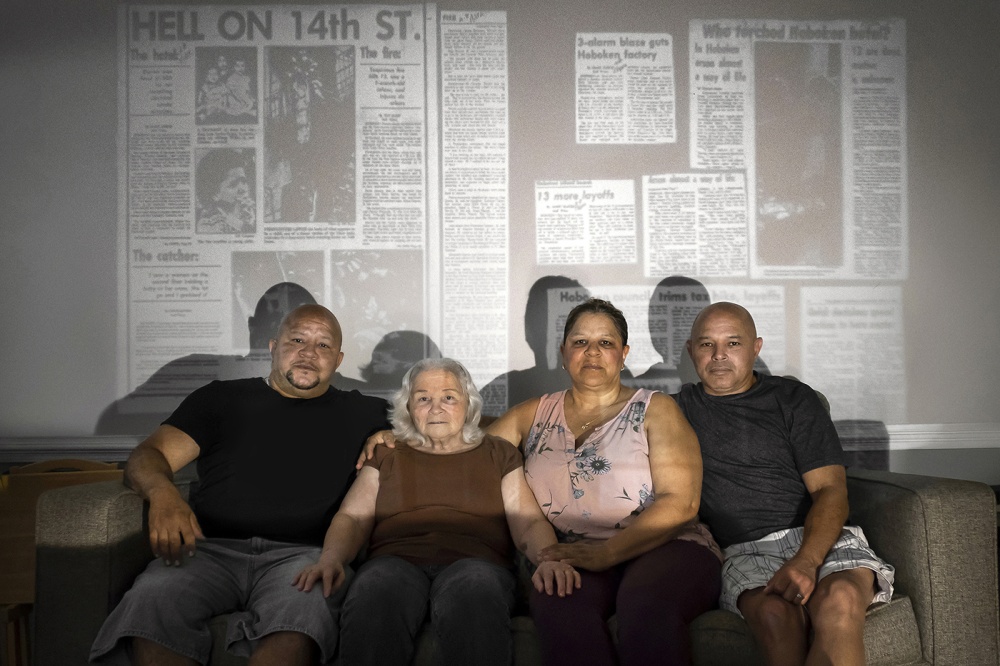
(Artwork © Christopher López; photograph provided by the artist)
The chasms of gentrification have long been a looming prospect in my life. I was born in the Bronx in 1984 to first-generation immigrant parents who, in just a few years prior to the Hoboken fires, had witnessed fires in The Bronx that would serve as the impetus to the arson epidemic that plagued Hoboken between 1978 and 1983. The Bronx was burning amid governmental abandon, ranking the borough the poorest congressional district in the nation at the time. Violence fueled by racial tensions coupled with a dilapidated infrastructure, arson for profit motives, and the governmental negligence that targeted the communities of color that resided there had finally revealed itself to the world by fire. From this context, my work on gentrification and its relation to fire as a method of eviction is no mere coincidence. For me, it is more a call to action to address yet another painful chapter in a long legacy of subjugation to violence and prejudice afflicted on Black and Brown people. In 1970, my mother (then eleven years old), along with her parents and three younger siblings survived an arson fire in their apartment building in East Harlem. They, like many other migrant families, were abandoned without aid. They relied on the kindness of friends and family for refuge for some months before settling in the Clason Point section of The Bronx. A small community of mostly Hispanic families on a bay dubbed Little Puerto Rico. From there, they witnessed The Bronx burn throughout the remainder of that decade. These events would indelibly transform their lives into burgeoning traumas that would set the tone for generations of Puerto Ricans who would find themselves migrating once again. Being constantly on the move, on the run, or run out is hard on people who are trying to grow new roots. There is a particular kind of shaming commonly attributed to violent displacement that is rarely spoken of in our communities. In this case, violence is underscored by victim blaming fueled by racism. Racist narratives created by the media dehumanize communities of color by blaming them for poor living conditions. They were blamed for the disrepair of their buildings rather than the proprietors. In reporting on arson, the media claimed that Latinos often packed in like rats and that the fires came as a result of either individual fighting among each other, lovers’ quarrels, or kids playing with matches. The public suspicion of arson-for-profit comes only after the death toll rises, once the damage is done, and there no longer remains a way to ignore the obvious. All of this contributes to the pain and angst that continues to harbor within a people who have yet to receive any form of justice for crimes committed against them. It is addressing this pain, the afterlives of those who remain in the wake of destruction, that drives my practice. By unfurling the complex layers of silenced histories, I hope to bring healing to these communities by creating space for them to grieve and to offer some semblance of justice.

(artwork © Christopher López; photograph provided by the artist)
Searching for people over forty years removed from events passed is no small task and requires a particular kind of endurance. I learned relatively quickly that this process is a tedious, constant confrontation with failure. Through all the unanswered phone calls, voicemails left, and text messages sent into the ether, all felt as though I was searching for a needle in a haystack; sifting through a labyrinth of names in newspapers lost in time. In the beginning, I relied on public record databases to find people whose names I pulled from newspaper articles. Most of the people affected by the fires were Hispanic. I would search a database that would yield dozens of people with the same name. This resulted in me having to contact each one individually until I found the right person. The first person I was able to successfully contact had a unique name. Antonio Olavarria, who still lives in Hoboken, and had survived an arson fire in 1980 when he was just nine years old. Antonio was forced to jump from his fourth-floor apartment to escape a blaze that had started in the hallway of his building at 67 Park Avenue. Antonio and I spoke over the course of several months. Sometimes we spoke about the fires and the changes the city endured, but mostly we talked about our lives. During our talks, Antonio would usually speak about his son Gabriel, and all of his sports achievements. He spoke of his son so often that eventually I realized that he was inadvertently telling me that he wanted his son to have the life in Hoboken that he never had. I arranged to photograph them both near their apartment by the river. They stood proudly for a portrait together at the pier. Antonio in red and Gabriel in blue. After taking the photos, Antonio said to me, “No one has ever taken photos like this of me and my son. Thank you, this means a lot to me.” In the three years that I have been working on this project, I have come to recognize the need to adopt a broader approach to the subject of gentrification beyond its marginalized narrative of events. It is common knowledge that greed, racism, inequity, and corruption are the principal elements at hand that level entire cities and overwhelmingly displace communities of color. I recognize the importance of contextualizing how specifically these processes unfurl; the history of redlining, the perversity of cultural appropriation, revanchism, settler colonialism, racist rebranding campaigns, landlord manipulation, the deliberate dismantling of essential services and utilities, structural neglect, destitution, arson for profit. Sadly, none of these things are surprising, unknown, or unfathomable to any of us as we each experience and witness human atrocities either directly or indirectly on a daily basis. What I find most interesting about each of these contexts is their ability to erase everything in their wake. The scale of destruction and the erasure of nearly entire populations is testament matched only by its brazenness. The devastation is so massive, so public, it almost renders itself invisible. To witness this level of death is so traumatic that it becomes buried. In this way, people are not only erased from a place physically but are also erased from the mind. Resisting the latter, so that suppression and the act of forgetting becomes something endemic, I have created a space for re-memory to thrive. Here, communal storytelling functions like bricks that support one another to build a new structure. To create a new foundation upon something that was lost or rather stolen. The reclamation of version and self-truth is a type of liberation that has the capacity to reverse the flow of power. It allows the living to live soundly, and visibly and honors the dead with dignity.
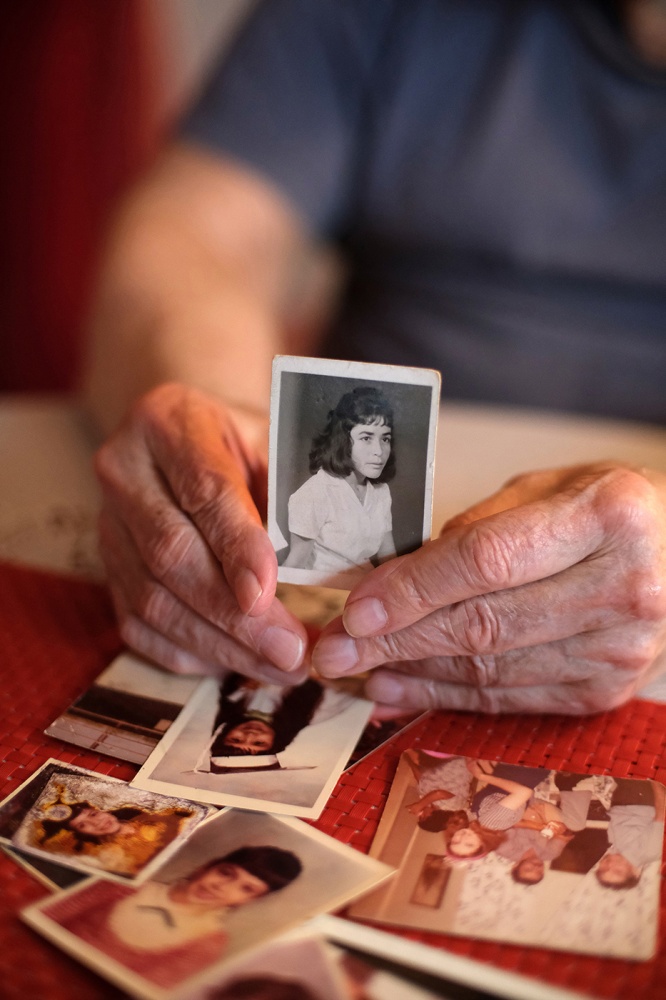
(Artwork © Christopher López; photograph provided by the artist)
I believe that the ghosts of the dead live among us, and the reasons and the ways in which they died so violently threatens us all. Between 1978 and 1983, fifty-six people, mostly Puerto Rican, mostly children, were killed in the fires, and of the dozens of arson fires committed, no one was ever convicted of any crime. It is precisely the absence of justice for these lives lost that enables the silencing of their history. Their deaths, and so their lives too, become invalidated due to lack of evidence leaving victims themselves in a void of doubt and unyielding grief. Indebted to the lives lost, so that they are not to be lost in vain, my efforts for this work require a kind of un-erasing through the process of re-imaging. Many of the people who survived the fires lost everything, including family photographs. Records of their lives were literally burned, relegating their past to a dreamlike stasis relying solely on whatever their memory will allow them to conjure. The collaborative portrait in this way is a reaffirmation that the things that were lost still remain with its memory keeper. Most of the portraits that I have made for this project are the result of months of conversations held between myself and the storyteller. Their portraits are a reflection of all our time spent sharing. The root of their message, the very thing they want to say, is revealed in their oral history as well as in their portrait. In this way, a photograph is not only a record of a single moment but is also a record of all the moments lost or un-imaged that came before it.
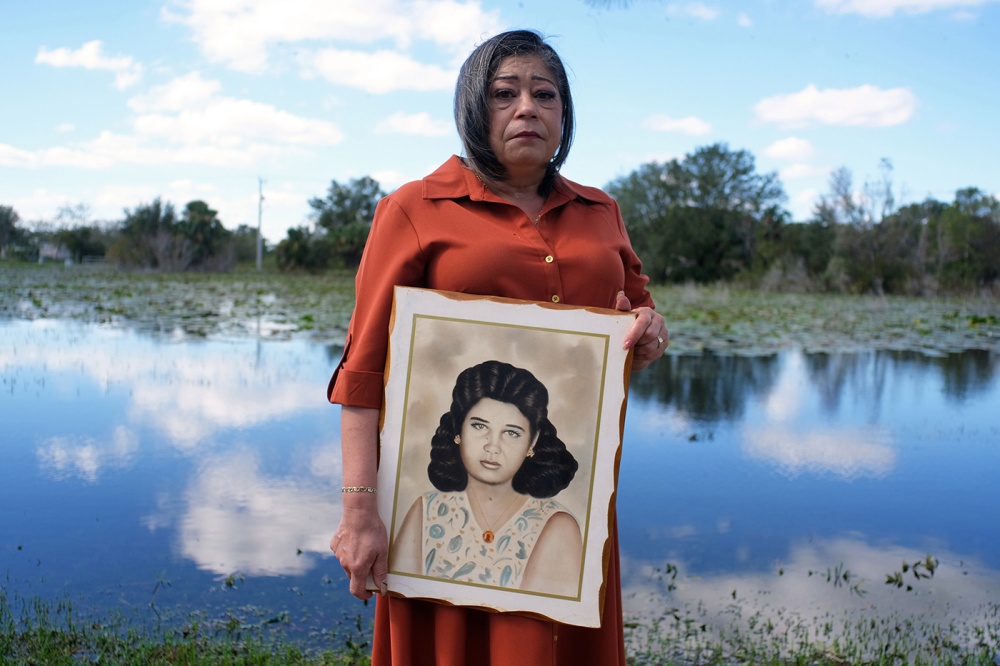
(Artwork © Christopher López; photograph provided by the artist)
Grief takes its toll in many forms and is often done in solitude as a cross we feel we must bear alone. The isolation of grief can distance us from the support we might already have in place that we are unable to see or are too hurt to embrace. This was certainly the case for Janet Ayala, a principal subject of my work. Janet would often describe this isolation as “putting on a mask.” In my image of Janet titled She Used to Pick Oranges, Janet holds one of the only pictures of her mother that remains. She stands in an orange dress in front of a large body of water that appears to be a lake but is a flooded piece of land that was inundated by hurricane Ian. She stares at us soberly, gripping the last surviving image of her mother.
Exactly two years after my initial research began, an exhibit of this work opened at the Hoboken Historical Museum in January 2023. The exhibition’s six-month run was extended by six months by popular demand. It marked the first time that any institution had ever addressed the city’s history of gentrification, especially that which concentrated on the devastation of the fires. Over the course of that year, I witnessed the space transform from a humble historical museum to a sanctuary. People who had experienced the times of the fires came to see what had never been seen before. They gathered collectively to mourn, to share, to listen, and to learn of, and from each other. More than just an exhibition, it became a place for them to grieve. Making these connections between our collective past, present, and future is at the center of discovery in my attempt to rehumanize our notions of place and our connectivity to them. In this rethinking, my work aims to offer the standpoint that a home is not so much a title of ownership than the fabric of life that sustains and cultivates that place through love. The notion of love and longing makes me reflect on one of my most cherished songs: “Puesto Vacante”by Eddie Palmieri as performed along with Lalo Rogriguez. The song lyrics speak of filling a void by offering a passionate account of longing. The performer decries with his llanto, “I am coming to fill a void that I left one day, because it is the one that belongs to me”. These lyrics resonate with me in the belief that filling this void is possible through the practice of re-memory and communal storytelling or simply by singing the song that belongs to you. As these voices converge their songs become a chorus. The once single lonely star that lived in the night sky becomes reimagined, drawn by the tips of pointing fingers to map their new constellations making their images clearer for us all to see.

(Artwork © Christopher López; photograph provided by the artist)
The Fires is a work in progress. There are plans to create an interactive website and book dedicated to this history. This project is dedicated to the memory of the fifty-six people who lost their lives in the fires and the legacies of the people who survived them.
Christopher López (b.1984), a Puerto Rican lens-based artist, educator, and public historian was born in The Bronx and was raised between New York and New Jersey. He has been working as a visual artist since 2005. To date, many of his works have been based on historical figures and events on the island of Puerto Rico. Often exploring diminishing histories, his photographs aim to reconcile the past as to confront the conditions and complexities surrounding identity and place existing within Puerto Rican people in our present day. Christopher’s artworks are currently in the permanent collections of El Museo Del Barrio, the World Trade Center Memorial Museum, and the National Portrait Gallery, Washington, DC.
- Dylan Gottlieb, “Hoboken Is Burning: Yuppies, Arson, and Displacement in the Postindustrial City,” Journal of American History 106, no. 2 (September 2019): 390–416. ↩

